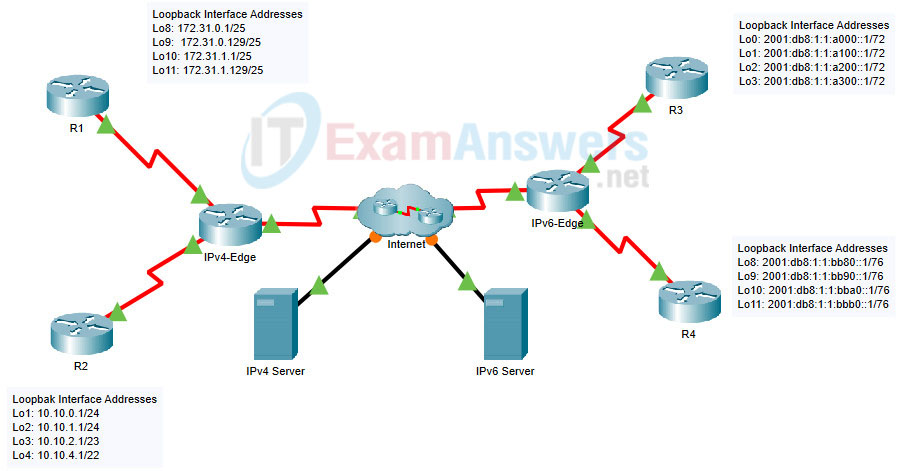5.2.3 Packet Tracer – Implement EIGRP for IPv4 and IPv6 (Answers)
Topology

5.2.3 Packet Tracer – Implement EIGRP for IPv4 and IPv6
Instructor Note: Red font color or gray highlights indicate text that appears in the instructor copy only.
IPv4 Addressing Table
| Device | Interface | IPv4 Address | Subnet Mask |
|---|---|---|---|
| IPv4-Edge | S0/0/0 | 172.31.6.1 | 255.255.255.252 |
| S0/0/1 | 10.10.8.1 | 255.255.255.252 | |
| S0/1/0 | 209.165.200.226 | 255.255.255.224 | |
| R1 | S0/0/0 | 172.31.6.2 | 255.255.255.252 |
| Lo8 | 172.31.0.1 | 255.255.255.128 | |
| Lo9 | 172.31.0.129 | 255.255.255.128 | |
| Lo10 | 172.31.1.1 | 255.255.255.128 | |
| Lo11 | 172.31.1.129 | 255.255.255.128 | |
| R2 | S0/0/1 | 10.10.8.2 | 255.255.255.252 |
| Lo1 | 10.10.0.1 | 255.255.255.0 | |
| Lo2 | 10.10.1.1 | 255.255.255.0 | |
| Lo3 | 10.10.2.1 | 255.255.254.0 | |
| Lo4 | 10.10.4.1 | 255.255.252.0 | |
| IPv4 Server | NIC | 64.100.1.10 | 255.255.255.0 |
IPv6 Addressing Table
| Device | Interface | IPv6 Address and Prefix Length |
|---|---|---|
| IPv6-Edge | S0/0/0 | 2001:DB8:A001:6::1/64 |
| S0/0/1 | 2001:DB8:A001:7::1/64 | |
| S0/1/0 | 2001:DB8:CAFE:1::2/64 | |
| R3 | S0/0/0 | 2001:DB8:A001:7::2/64 |
| R4 | S0/0/1 | 2001:DB8:A001:6::2/64 |
| IPv6 Server | NIC | 2001:DB8:CAFE:1000::A/64 |
Scenario
In this activity, you must implement EIGRP for IPv4 and IPv6 on two separate networks. Your task includes enabling EIGRP, assigning router IDs, changing the hello timers, and limiting EIGRP advertisements.
Instructions
Requirements
EIGRP for IPv4
• Implement EIGRP on IPv4-enabled routers using Autonomous System 1.
- Use a single classful network address to advertise the loopback interfaces.
- Use the wildcard mask to advertise the /30 networks between R1, R2 and IPv4-Edge.
- Use the default passive interface method and only allow EIGRP updates out the active EIGRP serial interfaces.
R1(config)# router eigrp 1 R1(config-router)# passive-interface default R1(config-router)# no passive-interface Serial0/0/0 R1(config-router)# network 172.31.0.0 R2(config)# router eigrp 1 R2(config-router)# passive-interface default R2(config-router)# no passive-interface Serial0/0/1 R2(config-router)# network 10.0.0.0 IPv4-Edge(config)# router eigrp 1 IPv4-Edge(config-router)# passive-interface default IPv4-Edge(config-router)# no passive-interface Serial0/0/0 IPv4-Edge(config-router)# no passive-interface Serial0/0/1 IPv4-Edge(config-router)# network 172.31.6.0 0.0.0.3 IPv4-Edge(config-router)# network 10.10.8.0 0.0.0.3
• Configure a directly attached default route on IPv4-Edge and propagate it in EIGRP updates.
IPv4-Edge(config)# ip route 0.0.0.0 0.0.0.0 Serial0/1/0 IPv4-Edge(config)# router eigrp 1 IPv4-Edge(config-router)# redistribute static
• Configure the serial interfaces between R1, R2 and IPv4-Edge to send hellos every 10 seconds.
R1(config)# interface s0/0/0 R1(config-if)# ip hello-interval eigrp 1 10 R2(config)# interface s0/0/1 R2(config-if)# ip hello-interval eigrp 1 10 IPv4-Edge(config)# interface s0/0/0 IPv4-Edge(config-if)# ip hello-interval eigrp 1 10 IPv4-Edge(config-if)# interface s0/0/1 IPv4-Edge(config-if)# ip hello-interval eigrp 1 10
• R1 and R2 should have a default route in the routing table (D*EX).
• Verify R1 and R2 can ping the IPv4 Server. IPv4 Server should also be able to ping every loopback address on R1 and R2.
EIGRP for IPv6
• Implement EIGRP for IPv6 on the IPv6-enabled routers using Autonomous System 1.
- Assign IPv6-Edge with the router ID of 1.1.1.1
- Assign R3 with the router ID of 3.3.3.3
- Assign R4 with the router ID of 4.4.4.4
IPv6-Edge(config)# ipv6 unicast-routing IPv6-Edge(config)# ipv6 router eigrp 1 IPv6-Edge(config-rtr)# eigrp router-id 1.1.1.1 IPv6-Edge(config-rtr)# no shutdown IPv6-Edge(config-rtr)# interface Serial0/0/0 IPv6-Edge(config-if)# ipv6 eigrp 1 IPv6-Edge(config-if)# interface Serial0/0/1 IPv6-Edge(config-if)# ipv6 eigrp 1 R3(config)# ipv6 unicast-routing R3(config)# ipv6 router eigrp 1 R3(config-rtr)# eigrp router-id 3.3.3.3 R3(config-rtr)# no shutdown R3(config-rtr)# interface Loopback0 R3(config-if)# ipv6 eigrp 1 R3(config-if)# interface Loopback1 R3(config-if)# ipv6 eigrp 1 R3(config-if)# interface Loopback2 R3(config-if)# ipv6 eigrp 1 R3(config-if)# interface Loopback3 R3(config-if)# ipv6 eigrp 1 R3(config-if)# interface Serial0/0/0 R3(config-if)# ipv6 eigrp 1 R4(config)# ipv6 unicast-routing R4(config)# ipv6 router eigrp 1 R4(config-rtr)# eigrp router-id 4.4.4.4 R4(config-rtr)# no shutdown R4(config-rtr)# interface Loopback8 R4(config-if)# ipv6 eigrp 1 R4(config-if)# interface Loopback9 R4(config-if)# ipv6 eigrp 1 R4(config-if)# interface Loopback10 R4(config-if)# ipv6 eigrp 1 R4(config-if)# interface Loopback11 R4(config-if)# ipv6 eigrp 1 R4(config-if)# interface Serial0/0/1 R4(config-if)# ipv6 eigrp 1
• Configure a directly attached default route on IPv6-Edge and propagate it in EIGRP updates.
IPv6-Edge(config)# ipv6 route ::/0 Serial0/1/0 IPv6-Edge(config)# ipv6 router eigrp 1 IPv6-Edge(config-rtr)# redistribute static
• R3 and R4 should show a default external route in the routing table.
• Verify R3 and R4 can ping the IPv6 Server. IPv6 Server should also be able to ping every loopback address on R3 and R4.
Answer Scripts
Router IPv4-Edge
enable configure terminal interface Serial0/0/0 ip hello-interval eigrp 1 10 interface Serial0/0/1 ip hello-interval eigrp 1 10 router eigrp 1 redistribute static passive-interface default no passive-interface Serial0/0/0 no passive-interface Serial0/0/1 network 172.31.6.0 0.0.0.3 network 10.10.8.0 0.0.0.3 ip route 0.0.0.0 0.0.0.0 Serial0/1/0 end
Router R1
enable configure terminal interface Serial0/0/0 ip hello-interval eigrp 1 10 router eigrp 1 passive-interface default no passive-interface Serial0/0/0 network 172.31.0.0 end
Router R2
enable configure terminal interface Serial0/0/1 ip hello-interval eigrp 1 10 router eigrp 1 passive-interface default no passive-interface Serial0/0/1 network 10.0.0.0 end
Router IPv6-Edge
enable configure terminal ipv6 unicast-routing interface Serial0/0/0 ipv6 eigrp 1 interface Serial0/0/1 ipv6 eigrp 1 ipv6 router eigrp 1 eigrp router-id 1.1.1.1 no shutdown redistribute static ipv6 route ::/0 Serial0/1/0 end
Router R3
enable configure terminal ipv6 unicast-routing interface Loopback0 ipv6 eigrp 1 interface Loopback1 ipv6 eigrp 1 interface Loopback2 ipv6 eigrp 1 interface Loopback3 ipv6 eigrp 1 interface Serial0/0/0 ipv6 eigrp 1 ipv6 router eigrp 1 eigrp router-id 3.3.3.3 no shutdown end
Router R4
enable configure terminal ipv6 unicast-routing interface Loopback8 ipv6 eigrp 1 interface Loopback9 ipv6 eigrp 1 interface Loopback10 ipv6 eigrp 1 interface Loopback11 ipv6 eigrp 1 interface Serial0/0/1 ipv6 eigrp 1 ipv6 router eigrp 1 eigrp router-id 4.4.4.4 no shutdown end
